It looks like you're using an Ad Blocker.
Please white-list or disable AboveTopSecret.com in your ad-blocking tool.
Thank you.
Some features of ATS will be disabled while you continue to use an ad-blocker.
14
share:
One of the most impressive and rarest event in the whole solar system is the planet occultation/transit. Often seen as "perfect planet alignment".
Of course, everybody knows what is an eclipse of the Sun. But in astronomical terms, it's just an occultation/transit of the Moon in front of the Sun.
A transit is when one heavenly body passes in front of another such that, as viewed from Earth, we can see one move across the other in the background.
An occultation is an event that occurs when one object is hidden by another object that passes between it and the observer.
The word is used in astronomy. It can also refer to any situation wherein an object in the foreground blocks from view (occults) an object in the background
There is a huge amount of studies and great pictures everywhere about Sun eclipses, and it will not be the subject here.
There are even more rare events that, sometimes, nobody's aware of. Simply because they never happen during the human life-time, and even sometimes they never happened in the whole
human history.
Let's first take a look at a classic view of the Solar System, just to give things a perspective:
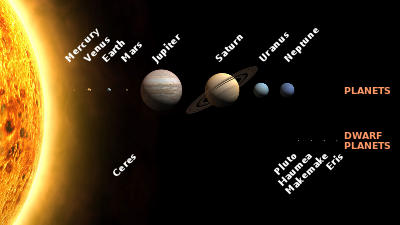
Note 1: Respective distances between planets are not respected.
Note 2: Pluto is not anymore a planet since 2006 and the new definition of what it means to be a "planet" within the Solar System from the International Astronomical Union.
As you can imagine, there are lots of possible combinations for the seven planets plus the Moon and the Sun.
However, while some are very common, others are very rare and sometimes occurs on a time scale that is in the tens of thousands of years or even more!!
Let's get into these exceptional events in details!
[NOTE: "---------->" means "occulted by" or "transit on"]
A- Transits of planets in front of the sun
The transit or passage of a planet across the face of the Sun is a relatively rare occurrence. As seen from Earth, only transits of Mercury and Venus are possible. There are approximately 13 transits of Mercury each century.
In comparison, transits of Venus occur in pairs with more than a century separating each pair.
1- Mercury---------->Sun
It's one of the most common transit, that occurs in a range comprised between 3 and 13 years.
The following table lists all transits of Mercury from 1901 through 2050. For a more complete and detaled list, see Seven Century Catalog of Mercury Transits: 1600 CE to 2300 CE.
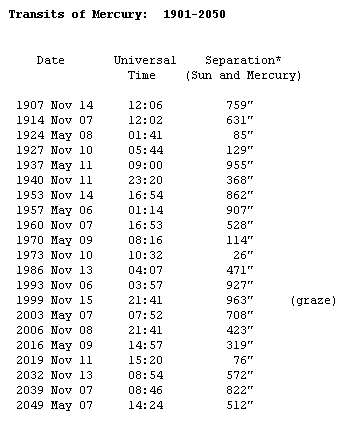
Source
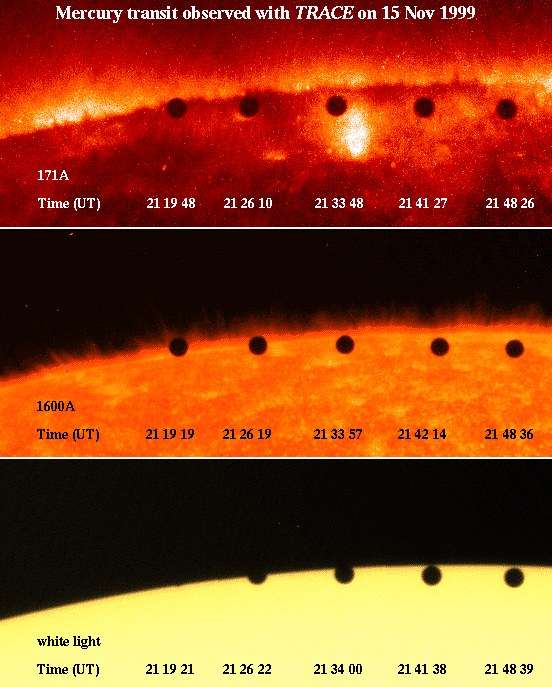
1999 Mercury transit

2003 Mercury transit view from SOHO
Source
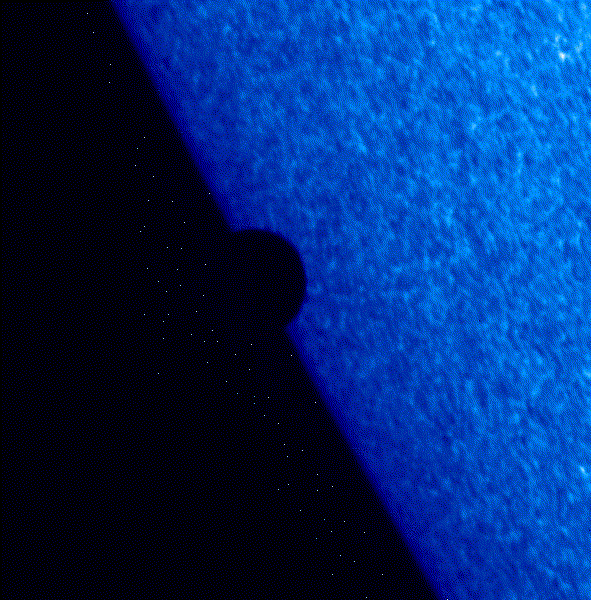
2006 Mercury transit observed with Hinode Solar Optical Telescope (SOT) where Mercury is clearly discernible as a dark disk with its diameter approximately 10 seconds of arc
Source
Related ATS thread:
Transit of Mercury November 8th
2- Venus---------->Sun
Source
The following table lists all transits of Venus during the 800 year period from 1601 through 2400.
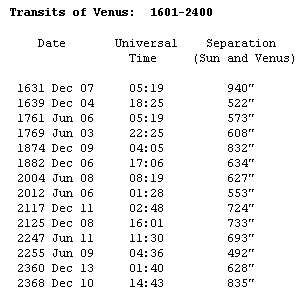
See also, for a more detailled table, Six Millennium Catalog of Venus Transits: 2000 BCE to 4000 CE.
Source
Interesting read that explains why the curious pattern in Venus transits dates: Transits of Venus
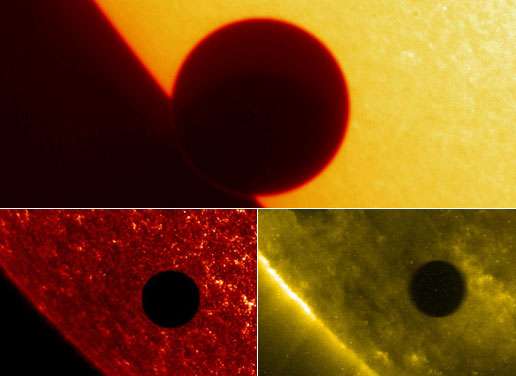
2004 Venus transit
Source
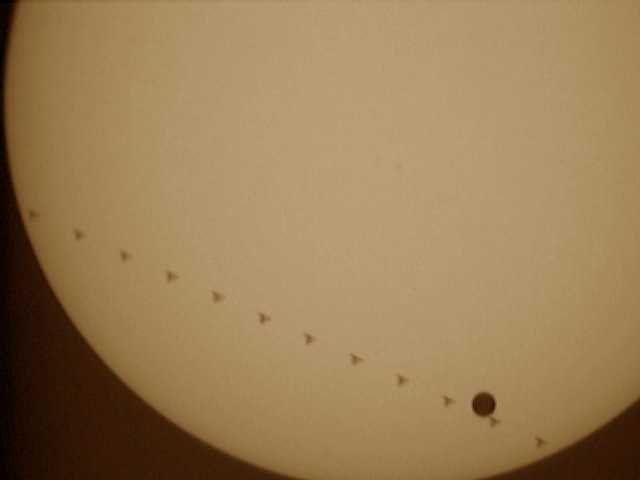
2004 Venus transit + ISS!
Related ATS threads:
Venus Transit of the Sun June 5th and 6th -- Or you can wait 115 years
Venus transit 2012
Transit of Venus 2012
Of course, everybody knows what is an eclipse of the Sun. But in astronomical terms, it's just an occultation/transit of the Moon in front of the Sun.
A transit is when one heavenly body passes in front of another such that, as viewed from Earth, we can see one move across the other in the background.
An occultation is an event that occurs when one object is hidden by another object that passes between it and the observer.
The word is used in astronomy. It can also refer to any situation wherein an object in the foreground blocks from view (occults) an object in the background
There is a huge amount of studies and great pictures everywhere about Sun eclipses, and it will not be the subject here.
There are even more rare events that, sometimes, nobody's aware of. Simply because they never happen during the human life-time, and even sometimes they never happened in the whole
human history.
Let's first take a look at a classic view of the Solar System, just to give things a perspective:

Note 1: Respective distances between planets are not respected.
Note 2: Pluto is not anymore a planet since 2006 and the new definition of what it means to be a "planet" within the Solar System from the International Astronomical Union.
As you can imagine, there are lots of possible combinations for the seven planets plus the Moon and the Sun.
However, while some are very common, others are very rare and sometimes occurs on a time scale that is in the tens of thousands of years or even more!!
Let's get into these exceptional events in details!
[NOTE: "---------->" means "occulted by" or "transit on"]
A- Transits of planets in front of the sun
The transit or passage of a planet across the face of the Sun is a relatively rare occurrence. As seen from Earth, only transits of Mercury and Venus are possible. There are approximately 13 transits of Mercury each century.
In comparison, transits of Venus occur in pairs with more than a century separating each pair.
1- Mercury---------->Sun
It's one of the most common transit, that occurs in a range comprised between 3 and 13 years.
all transits of Mercury fall within several days of May 08 and November 10. Since Mercury's orbit is inclined seven degrees to Earth's, it intersects the ecliptic at two points or nodes which cross the Sun each year on those dates.
If Mercury passes through inferior conjunction at that time, a transit will occur.
The following table lists all transits of Mercury from 1901 through 2050. For a more complete and detaled list, see Seven Century Catalog of Mercury Transits: 1600 CE to 2300 CE.

Source

1999 Mercury transit

2003 Mercury transit view from SOHO
Source

2006 Mercury transit observed with Hinode Solar Optical Telescope (SOT) where Mercury is clearly discernible as a dark disk with its diameter approximately 10 seconds of arc
Source
Related ATS thread:
Transit of Mercury November 8th
2- Venus---------->Sun
Transits of Venus are among the rarest of predictable astronomical phenomena. They occur in a pattern that repeats every 243 years, with pairs of transits eight years apart separated by long gaps of 121.5 years and 105.5 years.
The periodicity is a reflection of the fact that the orbital periods of Earth and Venus are close to 8:13 and 243:395 commensurabilities.
The next transit of Venus will be on 5 and 6 June 2012, and it will be the last Venus transit this century. The prior transit took place on 8 June 2004.
Source
The following table lists all transits of Venus during the 800 year period from 1601 through 2400.

See also, for a more detailled table, Six Millennium Catalog of Venus Transits: 2000 BCE to 4000 CE.
Source
Interesting read that explains why the curious pattern in Venus transits dates: Transits of Venus

2004 Venus transit
Source

2004 Venus transit + ISS!
Related ATS threads:
Venus Transit of the Sun June 5th and 6th -- Or you can wait 115 years
Venus transit 2012
Transit of Venus 2012
edit on 25-5-2012 by elevenaugust because: (no reason
given)
B- Occultations of planets by the Moon
The Moon passes through the ecliptic plane twice each lunar month so if a planet happens to be near one of these two 'nodes' of the lunar orbit it will be eclipsed.
The timing and positioning has to be just right because the Moon travels very fast along its orbit, and it is only about 1/2 degree in diameter.
Without looking at a planetary ephemeris, I would imagine that such an occultation happens probably no more than once a year, but for slow moving planets like Jupiter, Saturn and the rest of the outer planets, there are probably 'eclipse seasons' when several occultations over a period of one or more consecutive months would occur.
Mars, and the outer planets also perform retrograde motions which would enhance the number of occultations over a period of a few months.
During the eight millennium period 2 000 BC - 6 000 AD, Earth will experience 118 243 occultations of planets by Moon. The following table shows the number of times each planet is being occulted over this period.
Number of total occultations by planet:
Mercury 17.897
Saturn 17.496
Neptune 16.959
Mars 16.924
Jupiter 16.503
Uranus 16.244
Venus 16.220
There are a minimum of 1 and a maximum 51 occultations in every calendar year. Statistics for the number of occultation each year over the 8 000 year period you can find here.
The only year with only one occultation is 4194. The only year with 51 occultations is 1146.
Source
Like 2010, 2011 isn't a very lucky year for planetary occultation enthusiasts. In 2011 there are only three predicted occultations, slightly worse compared to the four occultations that took place in 2010.
The years before 2010 were much better, nine occultations in 2009 and an amazing total of twenty-four planetary occultations in 2008!
But how about the future? Well, than you will be lucky again because 2012 lists fourteen predicted occultations, with eight of them involving the planet Jupiter. The last occultation of Mars took place on 6th December 2010, visible in the USA.
See here for a complete table of all Lunar Occultations of Planets for 2012.
1- Mercury---------->Moon
Informations about this unknown occultation are hard to find and I guess that it's because of the difficulties to discern Mercury on the Moon disk, always overwhelmed by the Sun light close to it.
Thus the lack of photo of this event...
Average worldwide interval between occultations is 162 days. Best visible from the tropics a few times per century.
Anyway, it occurred in August 2007:
Source
..and in October 2011:
Source
The Moon passes through the ecliptic plane twice each lunar month so if a planet happens to be near one of these two 'nodes' of the lunar orbit it will be eclipsed.
The timing and positioning has to be just right because the Moon travels very fast along its orbit, and it is only about 1/2 degree in diameter.
Without looking at a planetary ephemeris, I would imagine that such an occultation happens probably no more than once a year, but for slow moving planets like Jupiter, Saturn and the rest of the outer planets, there are probably 'eclipse seasons' when several occultations over a period of one or more consecutive months would occur.
Mars, and the outer planets also perform retrograde motions which would enhance the number of occultations over a period of a few months.
During the eight millennium period 2 000 BC - 6 000 AD, Earth will experience 118 243 occultations of planets by Moon. The following table shows the number of times each planet is being occulted over this period.
Number of total occultations by planet:
Mercury 17.897
Saturn 17.496
Neptune 16.959
Mars 16.924
Jupiter 16.503
Uranus 16.244
Venus 16.220
There are a minimum of 1 and a maximum 51 occultations in every calendar year. Statistics for the number of occultation each year over the 8 000 year period you can find here.
The only year with only one occultation is 4194. The only year with 51 occultations is 1146.
During the period 2000-2099, the United States will experience about 39 favorable moon-planet occultation or 3.7% of all events (excluding Mercury, Neptune and Pluto).
However, 20 events will occur when the moon is greater than 80% illuminated. Not all locales will be able to view both the disappearance and reappearance of the planet.
No visible occultations occur in the US during these long gaps: 2005-2019, 2049-2057, and 2061-2069. Based on the period 2000-2499 A.D., the worldwide number of viewable occultations per century include: MERCURY: 0 to 3 events; VENUS: 0 to 5 events; MARS: 3 to 12 events; JUPITER: 2 to 15 events; and SATURN: 5 to 15. Only Mercury occultations are readily visible from the tropical latitudes in dark skies.
Most bright planets daylight occultations can be visible with some aid, thus increasing observable events by several factors.
Bright planet lunar occultations (Venus-Saturn) occurring worldwide in daylight and in dark for the next 500 years and a histogram showing the number of annual events.
Source
Like 2010, 2011 isn't a very lucky year for planetary occultation enthusiasts. In 2011 there are only three predicted occultations, slightly worse compared to the four occultations that took place in 2010.
The years before 2010 were much better, nine occultations in 2009 and an amazing total of twenty-four planetary occultations in 2008!
But how about the future? Well, than you will be lucky again because 2012 lists fourteen predicted occultations, with eight of them involving the planet Jupiter. The last occultation of Mars took place on 6th December 2010, visible in the USA.
See here for a complete table of all Lunar Occultations of Planets for 2012.
1- Mercury---------->Moon
Informations about this unknown occultation are hard to find and I guess that it's because of the difficulties to discern Mercury on the Moon disk, always overwhelmed by the Sun light close to it.
Thus the lack of photo of this event...
Average worldwide interval between occultations is 162 days. Best visible from the tropics a few times per century.
Anyway, it occurred in August 2007:
Occultation of Mercury by the Moon: Careful and very experienced telescopic observers can watch the New Moon occult (eclipse) the planet Mercury in CANCER after sunrise the morning of August 12th.
Mercury and the Moon will be ABOVE the Sun during this occultation, less than 10 degrees from the Sun, and only about 14 degrees above the horizon at the start of the event. Mercury, on the far side of the Sun, appears in its full phase at this time.
Telescopic observers should setup to keep the telescope in the shade if possible and begin watching a few minutes before 6:30 a.m.? Mercury will reappear from behind the Western edge of the Moon between about 7:45a.m. and 8:00a.m.
Source
..and in October 2011:
Next up is an interesting tri-conjunction involving the planets Mercury, Venus and a very slim crescent Moon low in the dusk skies on the 27th, with an occultation of Mercury by the Moon for those lucky Australian and New Zealand-based observers on the 28th
Source
edit on 25-5-2012 by elevenaugust because: (no
reason given)
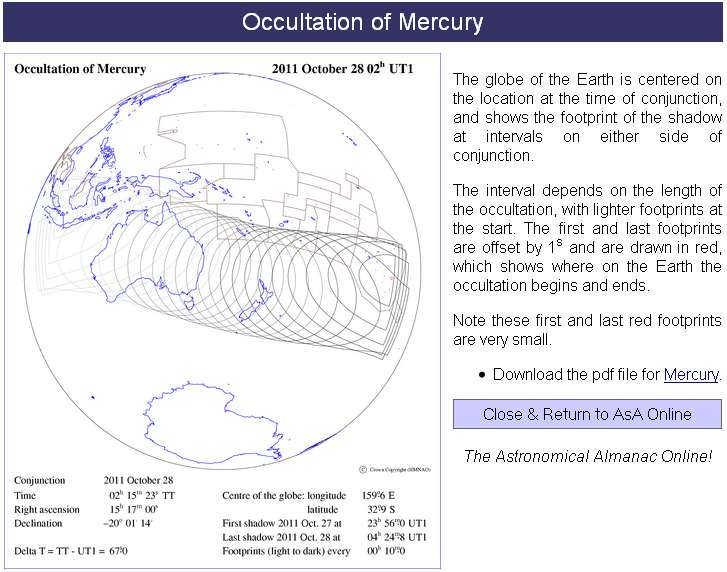
Earth's view of the Mercury/Moon 2011 occultation
Source
Next Mercury occultations will occurs on October 17 and December 12 2012.
2- Venus---------->Moon
It's a relatively frequent occultation ; it occurred in April 2009, 22; May 2010, 16; Sept 2010, 11; Nov 2010, 05; June 2011, 30.
Next occultation will be the Aug 2012, 13; Sept 2012, 08 and Feb 2014, 26.
The 2012 occultation will be visible from USA, Canada, Alaska and Eastern Asia:
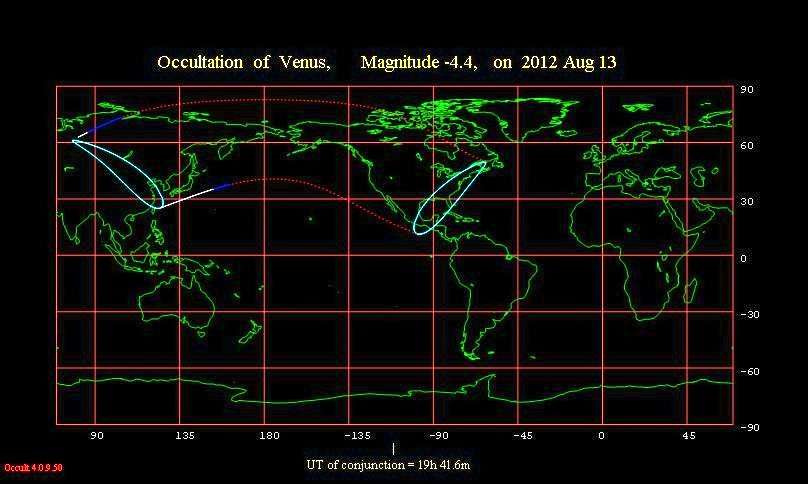
(cyan=occultation at moonrise/moonset; red dotted=daytime occultation; blue=twilight occultation; white=nighttime occultation)
See in details here for the Universal time of appearance and disappearance for each town in the world.
Average worldwide interval (based on 500 years) between occultations is 177 days. Per calendar year, zero to six occultations can occur.
For events occurring for the next +300 years, see here
For a histogram of events per year, see here
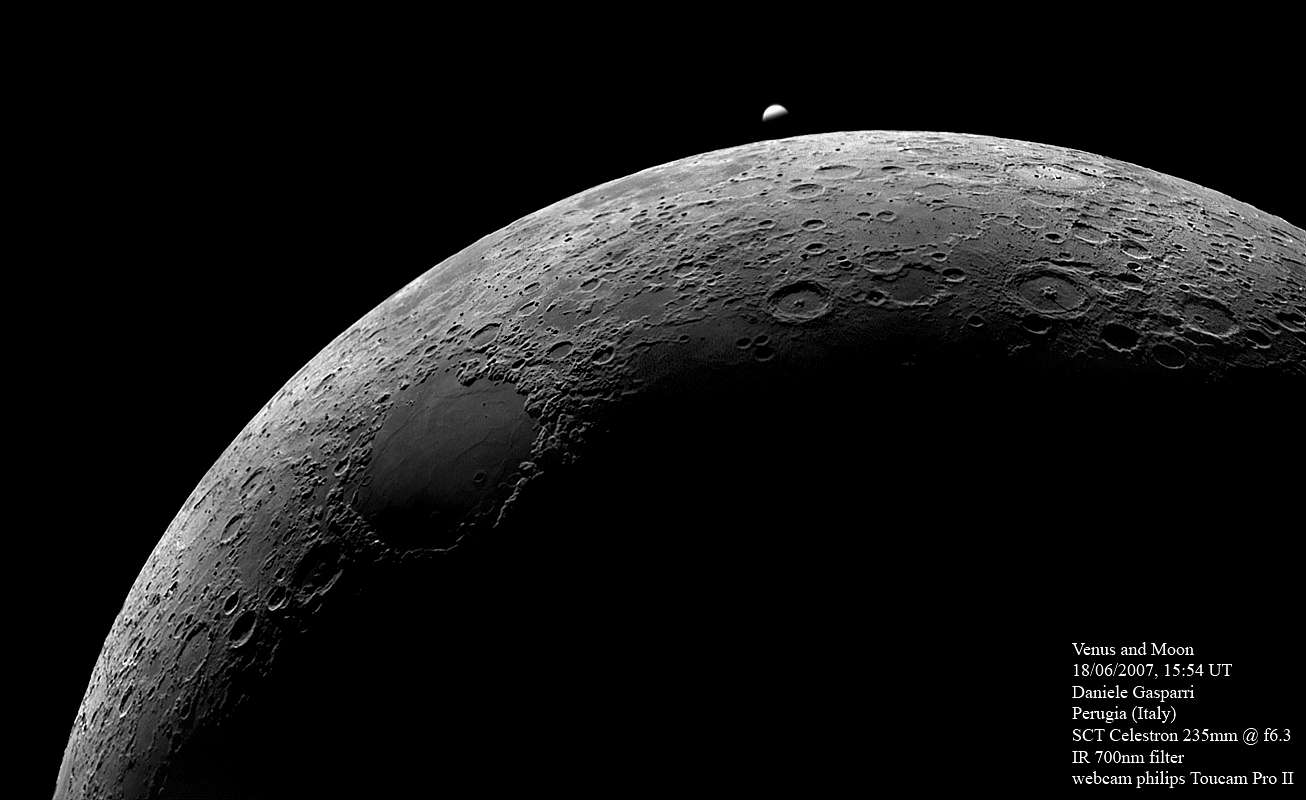
Source
3- Mars---------->Moon
Average worldwide interval (based on 500 years) between occultations is 180 days. Per calendar year, zero to five occultations can occur.
No annual occultation occur on average about once in 15 years.
Next occultation will occurs on September 19, 2012 and will be visible from South America with an illuminated Moon of 19%.
Other chances to see it will be the 06th July 2014, 21st March 2015 and 06th December 2015.
However, Occultations of Venus in a dark or twilit sky do not happen very often for any specific spot on Earth.
From Los Angeles, it happened only once in the 20th century (Jan. 13, 1923) and after this year, the next opportunity will not come again until Oct. 11, 2029.

27 August 2003 occultation
© Ron Dantowitz (Clay Center Observatory)
4- Jupiter---------->Moon
This is the most frequent occultation. Average worldwide interval (based on 500 years) between occultations is 180 days. Per calendar year, zero to 12 occultations can occur (a total of 13 consecutive moon encounters are possible). Annual gaps between occultations can range from one to three years.
This happens because during its 11.86 years traversing the ecliptic, Jupiter intersects the rotation of the line of possible lunar nodes for a period of 7.24 years; allowing for two periods of occultations. The time interval between the occultation periods averages 3.62 years.
For events occurring for the next +300 years see here
For a histogram of events per year, see here
There will be 8 event in 2012, all of these after June:
June 17
July 15
August 11
September 08
October 05
November 02 and 29
December 26
Here is for example the visibility of the 15 July occultation, with a -1.9 magnitude for Jupiter and a 15- Moon phase:
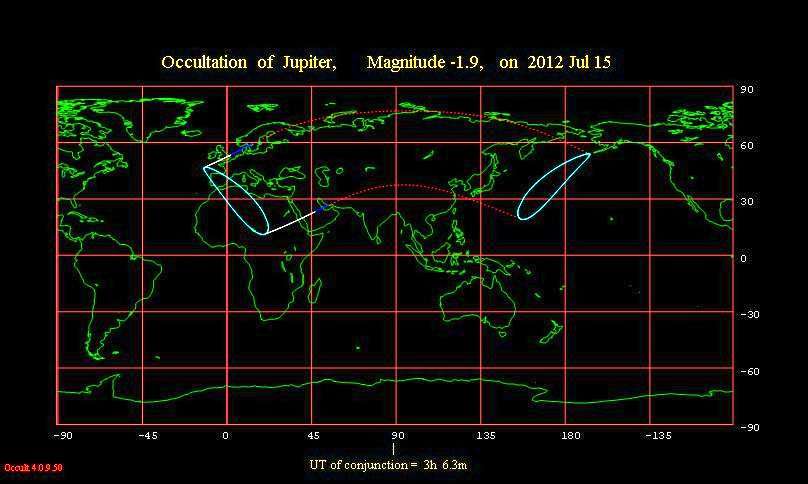
(cyan=occultation at moonrise/moonset; red dotted=daytime occultation; blue=twilight occultation; white=nighttime occultation)
See in details here for the Universal time of appearance and disappearance for each town in the world.
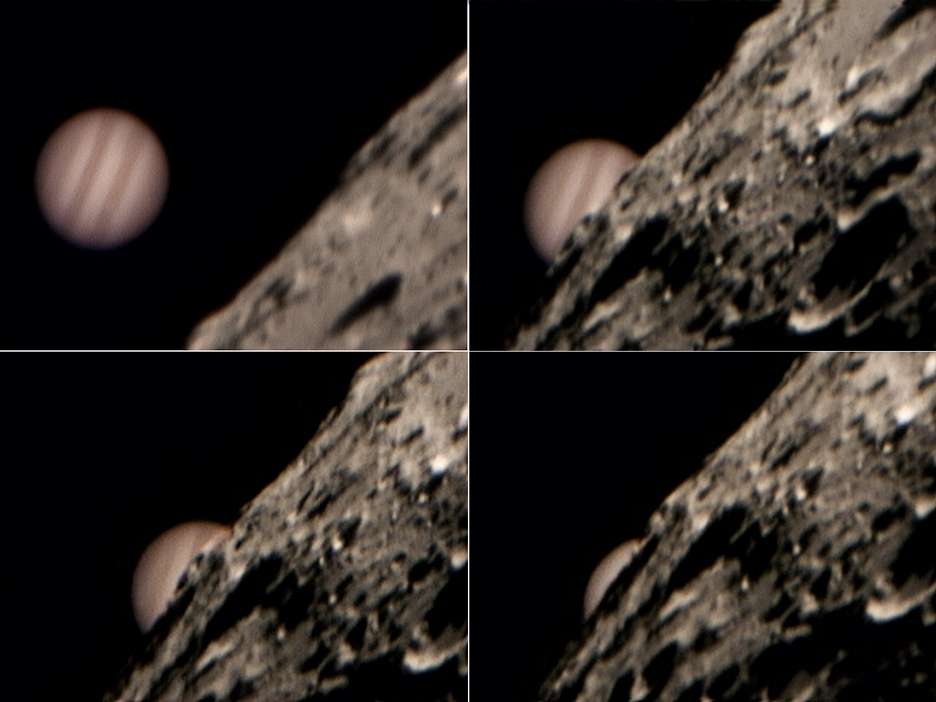
04 December 2004
Source

23 February 2002
Source

07 December 2004
Source
5- Saturn---------->Moon
Average worldwide interval (based on 500 years) between occultations is 168 days. Per calendar year, zero to 13 occultations can occur. Annual gaps between occultations can range from two to five years.
For events occurring for the next +100 years, see here
For a histogram of events per year, see here
Note that there was one ocuultation in 2005, 11 in 2006, then a 6 years gap, and then again one in 2013 and 11 in 2014.
So, like 2006, 2014 will be the year of the occultation of Saturn by the Moon!
Unfortunately, and while these occultations are frequents, they are often invisible because of the daylight occurrence...
Next events will be:
2013 December 01 and 29
2014 January 25
2014 February 21
2014 March 20
2014 April 17
2014 May 14
2014 June 10
2014 July 07
2014 August 02 and 31
2014 September 27
2014 October 25
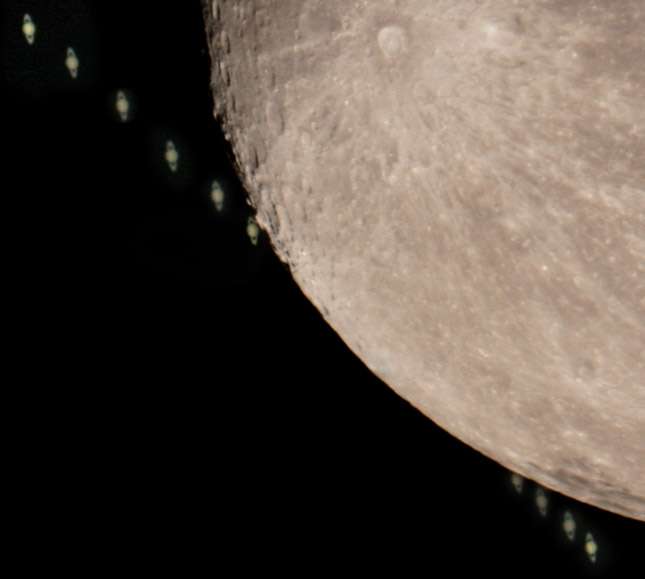
02 March 2007
Source
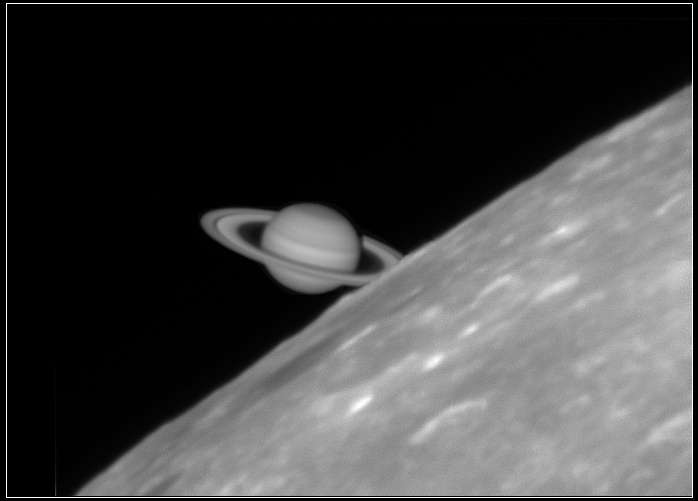
02 March 2007
Source
6- Uranus---------->Moon
With an average magnitude of +5.3/+6.0, Uranus makes occultations barely visible to the naked eyes. However, some astronomers succeed in taking wonderful shoots of the event (see below).
Here are the number of occultations by year of the 2000-2349AD period:

There was 16 events between 27 March 2006 and 12 May 2007 and next will be the 11st September 2014 and the 01st December 2014.
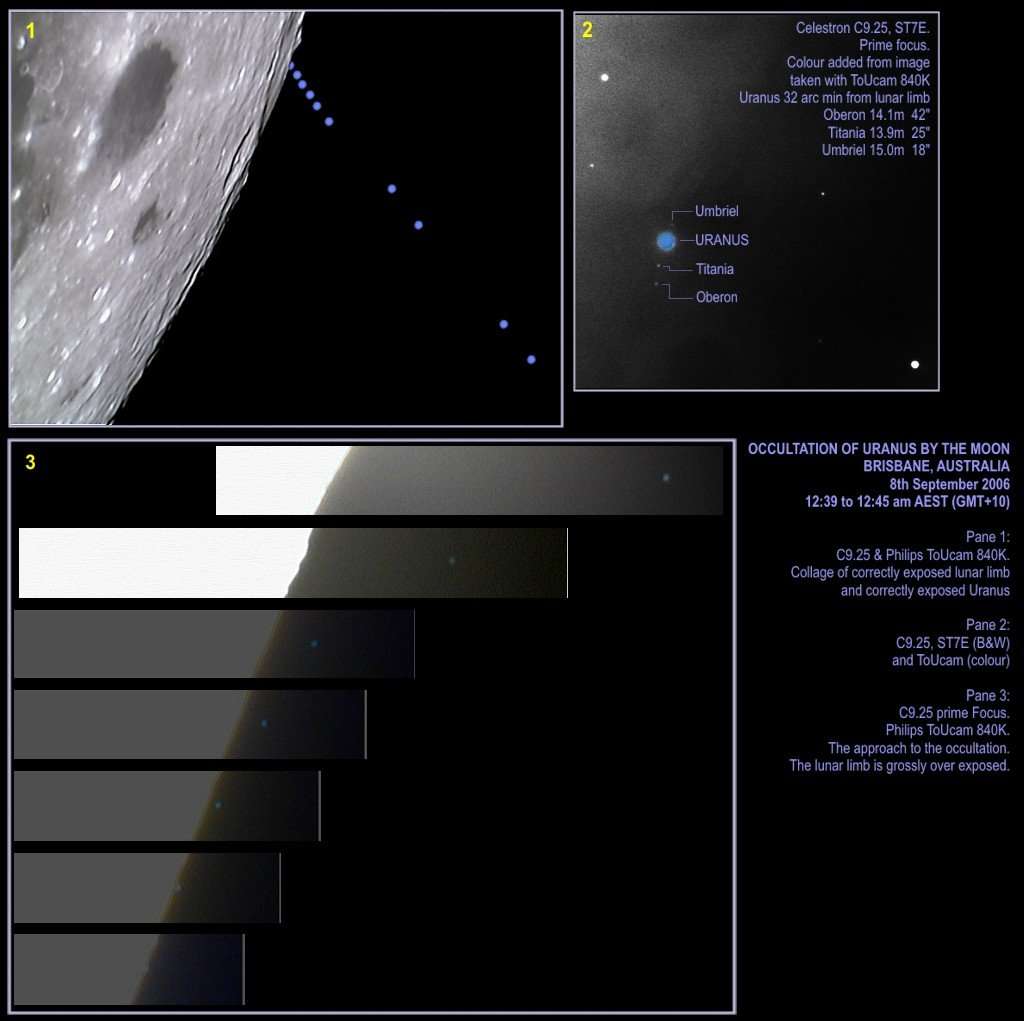
8 September 2006
Source
7- Neptune---------->Moon
Neptune, with an apparent magnitude of +8.0 is never visible to the naked eyes. The huge distance between the Moon and Neptune decrease the interest in such event
especially when you know that for successfully photography it, there are lots of conditions that are often missing, such as:
- Dark or twilit sky
- Visibility above ground zones
- A 235mm (and it's a minimum!) mirror diameter
- Good weather conditions
....
There was 17 events between 03rd July 2007 and 06th November 2008; unfortunately I wasn't able to find any informations on upcoming events for this occultation.
You can refer to the bibliography at the end for your own research using some dedicated predictions softwares, such as Occult 4.0.9 for example.
Here are two views of Neptune's occultation by the Moon, the first is generated by Computer and the other showing the path of the planet in the UK in September 2008:

23 June 2008
Source
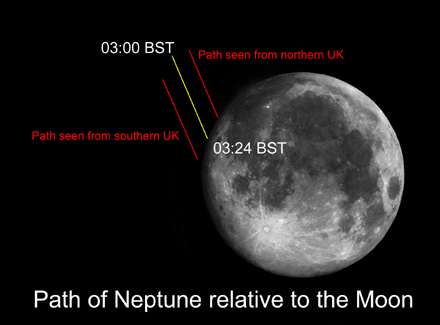
13 September 2008
Source
Average worldwide interval (based on 500 years) between occultations is 168 days. Per calendar year, zero to 13 occultations can occur. Annual gaps between occultations can range from two to five years.
For events occurring for the next +100 years, see here
For a histogram of events per year, see here
Note that there was one ocuultation in 2005, 11 in 2006, then a 6 years gap, and then again one in 2013 and 11 in 2014.
So, like 2006, 2014 will be the year of the occultation of Saturn by the Moon!
Unfortunately, and while these occultations are frequents, they are often invisible because of the daylight occurrence...
Next events will be:
2013 December 01 and 29
2014 January 25
2014 February 21
2014 March 20
2014 April 17
2014 May 14
2014 June 10
2014 July 07
2014 August 02 and 31
2014 September 27
2014 October 25

02 March 2007
Source

02 March 2007
Source
6- Uranus---------->Moon
With an average magnitude of +5.3/+6.0, Uranus makes occultations barely visible to the naked eyes. However, some astronomers succeed in taking wonderful shoots of the event (see below).
Here are the number of occultations by year of the 2000-2349AD period:

There was 16 events between 27 March 2006 and 12 May 2007 and next will be the 11st September 2014 and the 01st December 2014.

8 September 2006
Source
7- Neptune---------->Moon
Neptune, with an apparent magnitude of +8.0 is never visible to the naked eyes. The huge distance between the Moon and Neptune decrease the interest in such event
especially when you know that for successfully photography it, there are lots of conditions that are often missing, such as:
- Dark or twilit sky
- Visibility above ground zones
- A 235mm (and it's a minimum!) mirror diameter
- Good weather conditions
....
There was 17 events between 03rd July 2007 and 06th November 2008; unfortunately I wasn't able to find any informations on upcoming events for this occultation.
You can refer to the bibliography at the end for your own research using some dedicated predictions softwares, such as Occult 4.0.9 for example.
Here are two views of Neptune's occultation by the Moon, the first is generated by Computer and the other showing the path of the planet in the UK in September 2008:

23 June 2008
Source

13 September 2008
Source
8- Multiple occultations by the Moon
It is possible that the moon or another celestial body can occult multiple celestial bodies at the same time.
Such events are extremely rare and can be seen only from a small part of the world. The last event of such type was on April 23rd, 1998 when the moon occulted Venus and Jupiter simultaneously for observers on Ascension Island:

Credit & Copyright: Olivier Staiger.
This dramatic telephoto picture was taken at one such location, Ascension Island in the South Atlantic. The sunlit crescent is over-exposed revealing the rest of the lunar surface illuminated by faint earthshine.
Venus is emerging just beyond the crescent's tip and Jupiter is trailing above the dark lunar edge with a spot of light, Jupiter's moon Ganymede, between the lunar limb and the planet's disk.
Look closely at Jupiter and you can see yet another Jovian moon, Io, just visible against Jupiter's glare!
Source
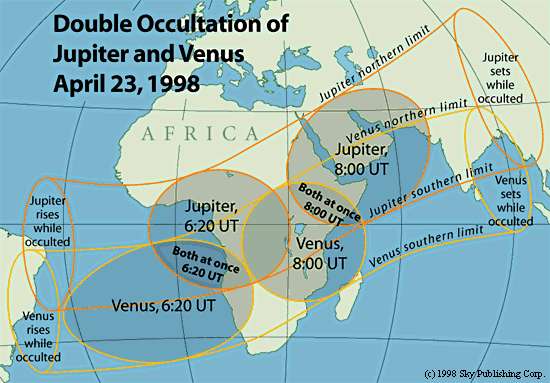
Source
Source
The five events were:
- 25th October 1682, both Jupiter and Saturn occulted by a 41% sunlit Waxing Crescent Moon. This event must have been spectacular, but with the telescope still in its infancy and the double occultation only visible over water on the Southern Hemisphere, it is probable that this event went unobserved.
- 11st February 1683, both Jupiter and Saturn again occulted by the moon and visible from South America south of latitude 40°S.
- 18th March 1757, both Venus and Mars occulted by a thin 5% sunlit Waxing Crescent Moon, shortly before New. Must be very impressive to see the drama and the beauty of two planet appears from behind and disappears behind the dark limb of a crescent Moon!!
- 28th February 1851, Mercury and Mars behind the Waxing crescent Moon and visible only from the Micronesian archipelago, north of Australia.
- 8th February 1951, Jupiter and Mars hidden 21' behind a crescent Moon and only visible from a location in ocean, centered on the International Date Line at 50°N.
- 4th May 2000, Venus and Uranus both occulted by the Moon were visible from Australia and New-Zealand during daylight.
Next events will be:
- 6th September 2037, Uranus and Jupiter occulted for only six minutes and visible from the Madagascar Basin, Southeast of Madagascar.
- 16th February 2038, Uranus and Jupiter again occulted for almost one hour and half and visible from a large part of Africa.
- 16th March 2038, Uranus and Jupiter moving very slowly in retrograde motion +/-0.5° double occultation limit for 57 consecutive days allowing the Moon to pass over the pair. Visible from the West coast of South America, and especially from the Galapagos Islands.
Two such occultation of the same planets one month apart in successive lunations are exceedingly rare, occurring perhaps once in one or two millennium...
- 16th August 2053, Venus and Uranus, 39° East from the Sun and only visible from the northern hemisphere.
9- Occultations by an eclipsed Moon
Last time Moon occulted a planet during an umbral eclipse was on 16 August 2008, but since it was Neptune occultation was only observable with telescopes.
About the inferiors planets, next events will be:
- Jupiter will be occulted by eclipsed Moon on 10th of June, 2932 (!!!)
- Mars almost 500 years earlier: on 26th of April, 2488 and
- Saturn "only" in 3.5 centuries, on 26th of July, 2344!
Source: Solar and Lunar Eclipses by M.M.Dagaev, Nauka (Science) Publishers, Moscow, 1st edition, 1978
Jupiter was observed and recorded occulted during the total eclipse of the Moon in 755 by Simeon of Durham in England.
I can't imagine the beauty of such an event!!
There will be no visible event in our lifetime, except for Uranus that will be occulted by the Total eclipse in:
- 8th October 2014
- 8th November 2022
This incredible occultation already occurred in 1938 and was visible from the East coast of North America but, oddly, was mentioned neither in the Nautical Almanach nor in the American Ephemeris for this year...
It is possible that the moon or another celestial body can occult multiple celestial bodies at the same time.
Such events are extremely rare and can be seen only from a small part of the world. The last event of such type was on April 23rd, 1998 when the moon occulted Venus and Jupiter simultaneously for observers on Ascension Island:

Credit & Copyright: Olivier Staiger.
This dramatic telephoto picture was taken at one such location, Ascension Island in the South Atlantic. The sunlit crescent is over-exposed revealing the rest of the lunar surface illuminated by faint earthshine.
Venus is emerging just beyond the crescent's tip and Jupiter is trailing above the dark lunar edge with a spot of light, Jupiter's moon Ganymede, between the lunar limb and the planet's disk.
Look closely at Jupiter and you can see yet another Jovian moon, Io, just visible against Jupiter's glare!
Source

Source
Only 6 such events have occurred since the invention of the telescope (considered as 1601AD) to 2000. Remarkably, in the 54 years following 2000 five more much events will occur, with three of them within a six-months period!!
Simultaneous occultations of two planets occurs with a frequency of between one and three per century. Generally, each such event can be seen favourably only within a rectangular area measuring only a dozen or so degrees (about 1000Kms)
both in latitude and longitude.
Source
The five events were:
- 25th October 1682, both Jupiter and Saturn occulted by a 41% sunlit Waxing Crescent Moon. This event must have been spectacular, but with the telescope still in its infancy and the double occultation only visible over water on the Southern Hemisphere, it is probable that this event went unobserved.
- 11st February 1683, both Jupiter and Saturn again occulted by the moon and visible from South America south of latitude 40°S.
- 18th March 1757, both Venus and Mars occulted by a thin 5% sunlit Waxing Crescent Moon, shortly before New. Must be very impressive to see the drama and the beauty of two planet appears from behind and disappears behind the dark limb of a crescent Moon!!
- 28th February 1851, Mercury and Mars behind the Waxing crescent Moon and visible only from the Micronesian archipelago, north of Australia.
- 8th February 1951, Jupiter and Mars hidden 21' behind a crescent Moon and only visible from a location in ocean, centered on the International Date Line at 50°N.
- 4th May 2000, Venus and Uranus both occulted by the Moon were visible from Australia and New-Zealand during daylight.
Next events will be:
- 6th September 2037, Uranus and Jupiter occulted for only six minutes and visible from the Madagascar Basin, Southeast of Madagascar.
- 16th February 2038, Uranus and Jupiter again occulted for almost one hour and half and visible from a large part of Africa.
- 16th March 2038, Uranus and Jupiter moving very slowly in retrograde motion +/-0.5° double occultation limit for 57 consecutive days allowing the Moon to pass over the pair. Visible from the West coast of South America, and especially from the Galapagos Islands.
Two such occultation of the same planets one month apart in successive lunations are exceedingly rare, occurring perhaps once in one or two millennium...
- 16th August 2053, Venus and Uranus, 39° East from the Sun and only visible from the northern hemisphere.
9- Occultations by an eclipsed Moon
Last time Moon occulted a planet during an umbral eclipse was on 16 August 2008, but since it was Neptune occultation was only observable with telescopes.
About the inferiors planets, next events will be:
- Jupiter will be occulted by eclipsed Moon on 10th of June, 2932 (!!!)
- Mars almost 500 years earlier: on 26th of April, 2488 and
- Saturn "only" in 3.5 centuries, on 26th of July, 2344!
Source: Solar and Lunar Eclipses by M.M.Dagaev, Nauka (Science) Publishers, Moscow, 1st edition, 1978
Jupiter was observed and recorded occulted during the total eclipse of the Moon in 755 by Simeon of Durham in England.
I can't imagine the beauty of such an event!!
There will be no visible event in our lifetime, except for Uranus that will be occulted by the Total eclipse in:
- 8th October 2014
- 8th November 2022
This incredible occultation already occurred in 1938 and was visible from the East coast of North America but, oddly, was mentioned neither in the Nautical Almanach nor in the American Ephemeris for this year...
edit on 25-5-2012 by elevenaugust because: (no reason given)
C- Occultations of planets by the Sun
Yes, and nobody's think about it, but the Sun also occults ALL the other planets of the solar system. But due to the fact that it's impossible from the Earth to observe such occultations, there's no (or few) documentation about it.
Nonetheless, and out of curiosity, you can find a list of these events here, with this extract the the next 10 years:
2013/05/11 20:57:05 0.08157 1.010 1.323 35592 Mercury
2013/06/19 16:13:04 0.22782 1.016 6.137 33706 Jupiter
2015/11/17 13:00:41 0.24464 0.989 1.446 33926 Mercury
2016/06/06 21:54:43 0.00542 1.015 1.735 166032 Venus
2019/12/27 18:26:55 0.09523 0.983 6.213 56646 Jupiter
2020/01/13 15:16:57 0.03643 0.983 11.017 51962 Saturn
2020/05/04 22:01:28 0.10703 1.009 1.325 34804 Mercury
2022/11/08 17:22:04 0.08820 0.991 1.440 71388 Mercury
2023/11/18 05:24:36 0.11517 0.989 2.526 139874 Mars
Yes, and nobody's think about it, but the Sun also occults ALL the other planets of the solar system. But due to the fact that it's impossible from the Earth to observe such occultations, there's no (or few) documentation about it.
Nonetheless, and out of curiosity, you can find a list of these events here, with this extract the the next 10 years:
2013/05/11 20:57:05 0.08157 1.010 1.323 35592 Mercury
2013/06/19 16:13:04 0.22782 1.016 6.137 33706 Jupiter
2015/11/17 13:00:41 0.24464 0.989 1.446 33926 Mercury
2016/06/06 21:54:43 0.00542 1.015 1.735 166032 Venus
2019/12/27 18:26:55 0.09523 0.983 6.213 56646 Jupiter
2020/01/13 15:16:57 0.03643 0.983 11.017 51962 Saturn
2020/05/04 22:01:28 0.10703 1.009 1.325 34804 Mercury
2022/11/08 17:22:04 0.08820 0.991 1.440 71388 Mercury
2023/11/18 05:24:36 0.11517 0.989 2.526 139874 Mars
excellent stuff - and just to have a dig at cetrain elements here - thier alledged" nibiru " has never been observed to accult any other celestial
body
Wow! This is an amazing thread. I printed a PDF of it to reference later. Fantastic job of putting this all together, explaining it so well, and
providing such beautiful pictures! Thank you so much for posting!
Wow!
*Jaw Dropped*
Eleven, your threads are always so brilliant. Totally void of faff, nothing but incredible documentation of true celestial mechanics and science. How on earth some people claim the suns in the wrong spot is beyond me, especially when these types of calculations of always spot on the money. Such a magnificent mathematical dance that I pine for a great scope one day!
Also, I've missed your threads lately! S&F all round for a fascinating subject and spot on research, if only ATS could pay you to do threads full time!
*Jaw Dropped*
Eleven, your threads are always so brilliant. Totally void of faff, nothing but incredible documentation of true celestial mechanics and science. How on earth some people claim the suns in the wrong spot is beyond me, especially when these types of calculations of always spot on the money. Such a magnificent mathematical dance that I pine for a great scope one day!
Also, I've missed your threads lately! S&F all round for a fascinating subject and spot on research, if only ATS could pay you to do threads full time!
Amazing thread, had to see it all but, I was wondering if Mars occults/transits the gas giants. I suppose Mars could only occult Uranus or
Neptune if Mars was at a favorable opposition.
a reply to: elevenaugust
Please explain it to me like im a retarded monkey reading it for the first time, or a link to Dummies, please
Please explain it to me like im a retarded monkey reading it for the first time, or a link to Dummies, please
new topics
-
Holy Cow! Erm...Six Legged Turkey!!
World Sports: 2 hours ago -
Ben Habib has Left Reform UK
Regional Politics: 5 hours ago -
Turkey Day Rhyme…
Short Stories: 5 hours ago -
Can someone please translate Biden's speech?
US Political Madness: 6 hours ago -
NIH Chief Confesses COVID Initiatives Were "Completely Made Up " OMG Investigates
Health & Wellness: 7 hours ago -
Awesome Dip Recipe
Food and Cooking: 10 hours ago -
Vladimir Putin's speech at the meeting of the CSTO Collective Security Council
World War Three: 10 hours ago
top topics
-
NIH Chief Confesses COVID Initiatives Were "Completely Made Up " OMG Investigates
Health & Wellness: 7 hours ago, 9 flags -
Vladimir Putin's speech at the meeting of the CSTO Collective Security Council
World War Three: 10 hours ago, 8 flags -
Can someone please translate Biden's speech?
US Political Madness: 6 hours ago, 7 flags -
Traveling the world with no passport
Social Issues and Civil Unrest: 15 hours ago, 6 flags -
Awesome Dip Recipe
Food and Cooking: 10 hours ago, 5 flags -
Turkey Day Rhyme…
Short Stories: 5 hours ago, 5 flags -
Ben Habib has Left Reform UK
Regional Politics: 5 hours ago, 4 flags -
Holy Cow! Erm...Six Legged Turkey!!
World Sports: 2 hours ago, 2 flags
active topics
-
Vladimir Putin's speech at the meeting of the CSTO Collective Security Council
World War Three • 59 • : lostgirl -
NIH Chief Confesses COVID Initiatives Were "Completely Made Up " OMG Investigates
Health & Wellness • 13 • : underpass61 -
V.P. Kamala Harris releases a video and nobody understands why
US Political Madness • 81 • : chr0naut -
Holy Cow! Erm...Six Legged Turkey!!
World Sports • 2 • : RazorV66 -
Awesome Dip Recipe
Food and Cooking • 5 • : JJproductions -
Traveling the world with no passport
Social Issues and Civil Unrest • 8 • : annonentity -
Turkey Day Rhyme…
Short Stories • 4 • : JJproductions -
Mood Music Part VI
Music • 3721 • : BrucellaOrchitis -
Interesting Video-UFO?
Aliens and UFOs • 20 • : BrucellaOrchitis -
Happy Thanksgiving to ATS
General Chit Chat • 13 • : gort69
14
